Freedom of Information statistics: April to June 2021 bulletin
Updated 15 December 2021
Statistical enquiries: George Ball
Press enquiries: Josh Mines (079 3551 8461)
Next publication: 15 December 2021
1. Overview
This bulletin presents headline statistics for Freedom of Information (FOI) requests in central government for April to June 2021 (Q2), including key breakdowns by monitored body.
1.1 Key statistics
-
From April to June 2021 there were 12,983 FOI requests received across all monitored bodies*.This is an increase of 3,778 (+41.0%) from the same quarter in 2020 and represents the largest number of FOI requests received in Q2 since recording began in 2005.
-
Across all monitored bodies, 87% of requests were responded to in time, up from 84% in Q2 2020.
-
Of the 12,983 FOI requests received, 9,605 were resolvable. Of these, 38% were granted in full, up from 37% from the same period in 2020 and 37% were withheld in full, up from 36% from the same period in 2020. The remaining resolvable requests were not yet processed or were partially withheld.
-
Of the 4,891 requests withheld in full or in part, 30% were withheld due to the cost of response exceeding the limit, 4% were withheld as vexatious or repeated, and the remaining 66% fell under other exemptions.
*A full list of monitored bodies included in these statistics is provided in the scope of monitoring section.
Figure 1.1: Volume of FOI requests by quarter since Q2 2018 (see Worksheet 2 of data tables)
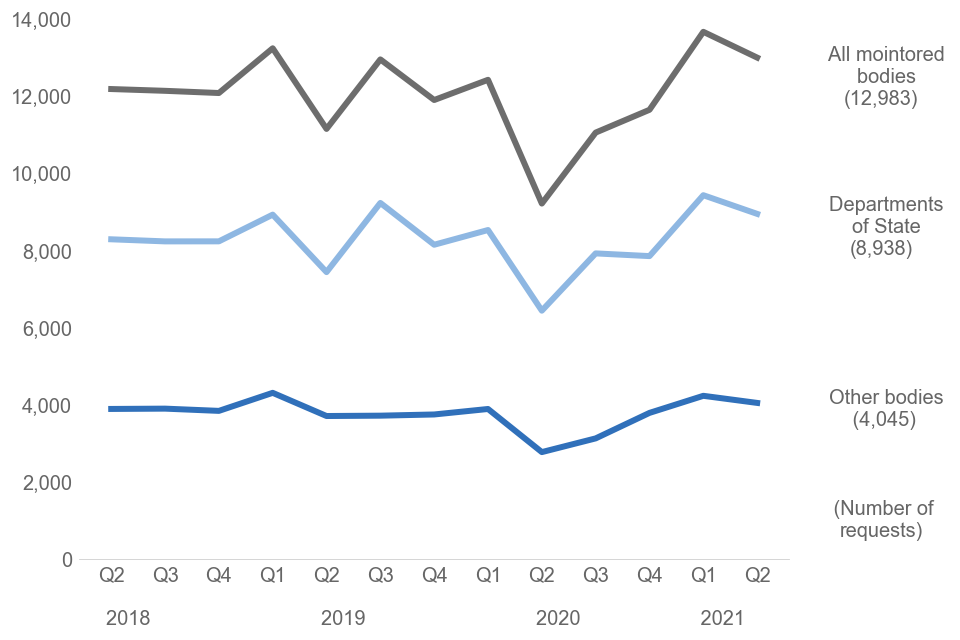
FOI requests by quarter, line chart
Figure 1.2: Number of monitored bodies by their percentage of responses to requests in time since Q2 2020 (see Worksheet 4 of data tables)

1.2 Coronavirus (COVID-19)
Quarterly data over the last year are affected by the coronavirus (COVID-19) pandemic in the UK. Use caution when interpreting more recent data and comparing with pre-pandemic time periods. More information is available in the notes section.
2. Volumes
From April to June 2021 there were 12,983 FOI requests received across all monitored bodies. This is an increase of 3,778 (+41.0%) from the same quarter in 2020 and represents the largest number of FOI requests received in Q2 since recording began in 2005.
The majority (8,938) of these requests were at Departments of State, with the remaining 4,045 being received by other monitored bodies.
The Department for Health and Social Care, the Ministry of Defence, the Ministry of Justice, and the Home Office accounted for just under half (48%) of requests to Departments of State; while the Health and Safety Executive, National Archives and HM Revenue & Customs accounted for 61% of requests to other monitored bodies.
The National Archives had the largest increase in requests (+398) amongst all monitored bodies compared to the same period in 2020, followed by the Ministry of Defence (+393). Six of the monitored bodies recorded fewer requests than in Q2 2020, with Rural Payments Agency (-15) recording the largest decrease.
Figure 2.1: Volume of FOI requests by quarter since Q2 2018 (see Worksheet 2 of data tables)

FOI requests by quarter, line chart
Figure 2.2: Proportion of FOI requests across all monitored bodies in Q2 April to June 2021 (see Worksheet 1 of data tables)
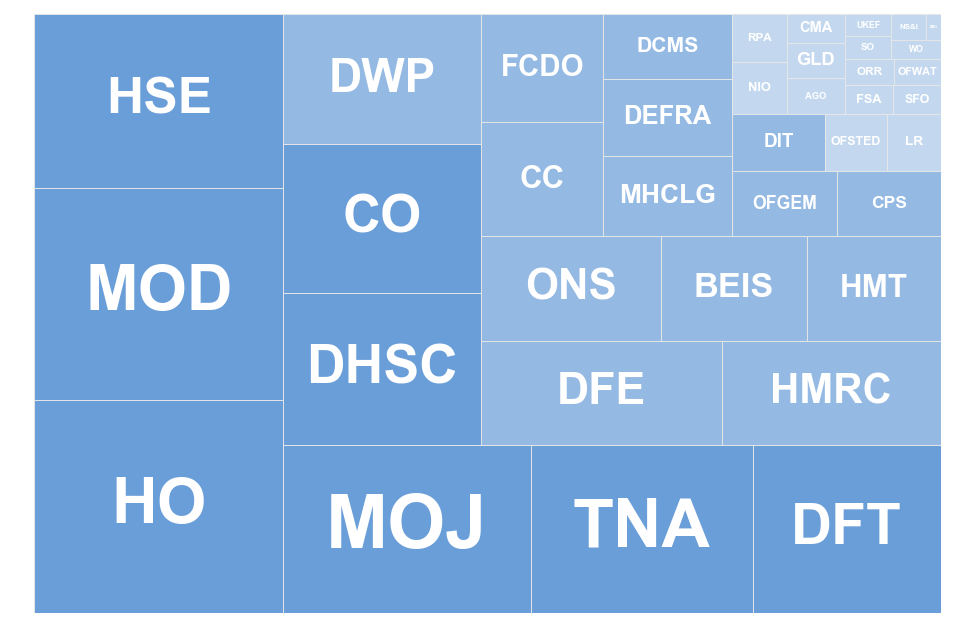
Treemap showing total volume of FOI requests in Q2 2021
Figure 2.3: Volume of FOI requests across all monitored bodies in Q2 April to June 2021 compared to in Q2 April to June 2020 (see Worksheet 2 of data tables)
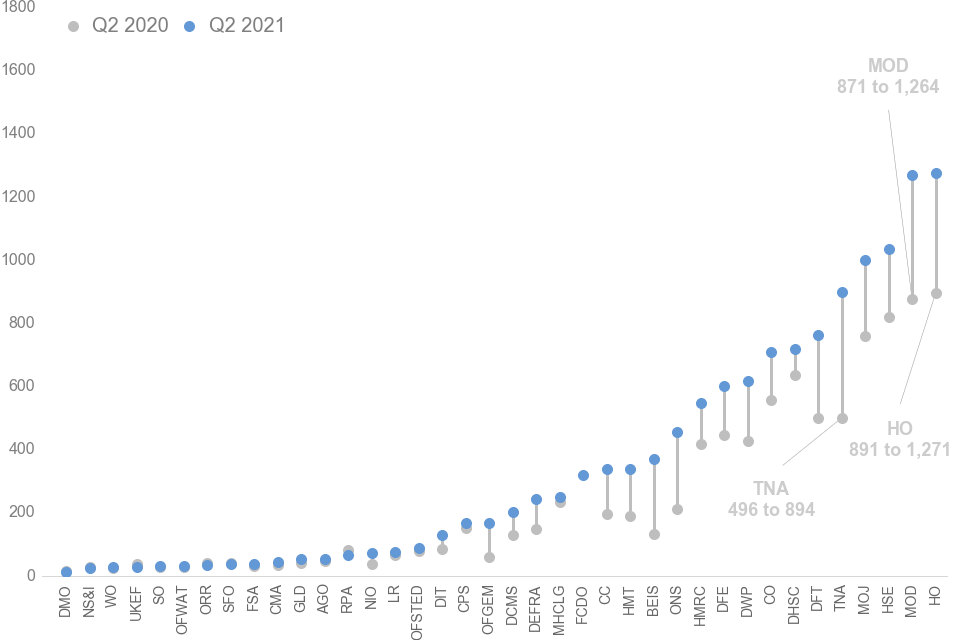
2.1 Statistical Note
Comparisons are made to the same period in the previous year rather than the previous quarter due to consistent differences in the volume of requests per quarter each year.
3. Timeliness
3.1 Timeliness
The FOI Act requires public bodies to respond to requests for information in a timely manner. ‘In time’ responses are those processed within the statutory deadline (20 working days) or subject to a permitted deadline extension, including:
- Additional time for public interest tests under the FOI act.
- Extensions under the Environmental Information Regulations for complex requests.
- 10 additional working days for archival records from the National Archives.
Across all monitored bodies, 87% of requests were responded to in time, up from 84% in Q2 2020.
- Across all Departments of State, 87% of requests were responded to in time, up from 83% from the same period in 2020.
- Across all other monitored bodies 86% of requests were responded to in time, down from 87% from the same period in 2020.
Figure 3.1: Percentage of responses to FOI requests in time across all monitored bodies since Q2 2018 (see Worksheet 4 of data tables)

FOI requests by quarter, line chart
Figure 3.2: Number of monitored bodies by their percentage of responses to requests in time since Q2 2020 (see Worksheet 4 of data tables)

Figure 3.3: Departments of State and Other monitored bodies: Timeliness of response to FOI requests (see Worksheet 3 of data tables)

3.2 Statistical Note
Where monitored bodies only receive a small number of requests they can demonstrate higher variability in their quarterly statistics.
4. Outcomes
4.1 Important Note
‘Procedural refusals’ within the statistics are classified as resolvable requests that have been fully withheld. ‘Resolvable requests’ are defined as all those where it is possible to make a substantive decision on whether to release the requested information. They exclude requests which are lapsed or ‘on-hold’, where the information is not held, and where it was necessary to provide advice and assistance, since, in each of these cases, it would not have been possible to resolve the request in the form it was asked.
FOI requests that have been refused for being vexatious or repeated, along with those refused on cost grounds are treated and included in these statistics as resolvable requests that have been ‘fully-withheld’. These types of refusals are referred to as ‘procedural refusals’ in these statistics.
To better understand the impact on the statistics of classifying ‘procedural refusals’ as resolvable requests that have been ‘fully-withheld’, additional statistics are presented in section 4.2 that excludes ‘procedural refusals’ from resolvable requests and requests that have been ‘fully-withheld’.
4.2 Outcomes including procedural refusals
12,983 “non-routine”* requests were received in April to June 2021. Of these, 9,605 (74%) were resolvable. Resolvable requests are those where it was possible to give a substantive decision on whether to release the requested information. Of these:
-
3,654 were granted in full.
-
4,891 were withheld in full** or in part, where:
-
163 were vexatious, as defined in Section 14 of the Act.
-
44 were repeated, as defined in Section 14 of the Act.
-
1,463 had a cost of response which exceeded the limit as defined in Section 12 of the Act.
-
3,221 involved information subject to one of the exemptions and exceptions listed under Sections 22-44.
-
1,060 were not yet processed.
3,373 (26%) requests were not resolvable. Of these:
-
734 requests required further clarification prior to responding, and monitored bodies provided “advice and assistance” on how to reformulate the request.
-
2,639 involved information not held by the responding body.
5 (0.0%) were on hold at the time of monitoring.
*For more detail and definition of ‘non-routine’ requests see Notes section.
**Fully withheld requests” includes requests which were refused because it was estimated that the cost of complying with the request would exceed the appropriate limit or because the request was considered vexatious or repeated. Please note that requests refused on these grounds may include refusals where information is not held.
Figure 4.1.1: Outcomes of FOI requests received in Q2 April to June 2021 (see Worksheet 5 of data tables and csv dataset)
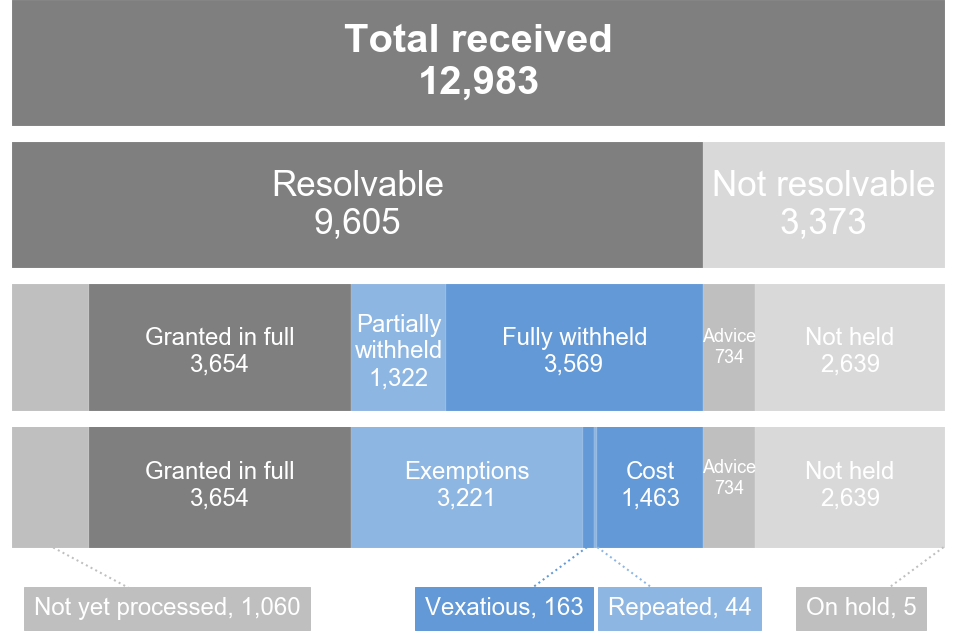
Figure 4.1.2: Departments of State and other monitored bodies: Outcomes of FOI requests as a percentage of resolvable requests (see Worksheet 5 of data tables)
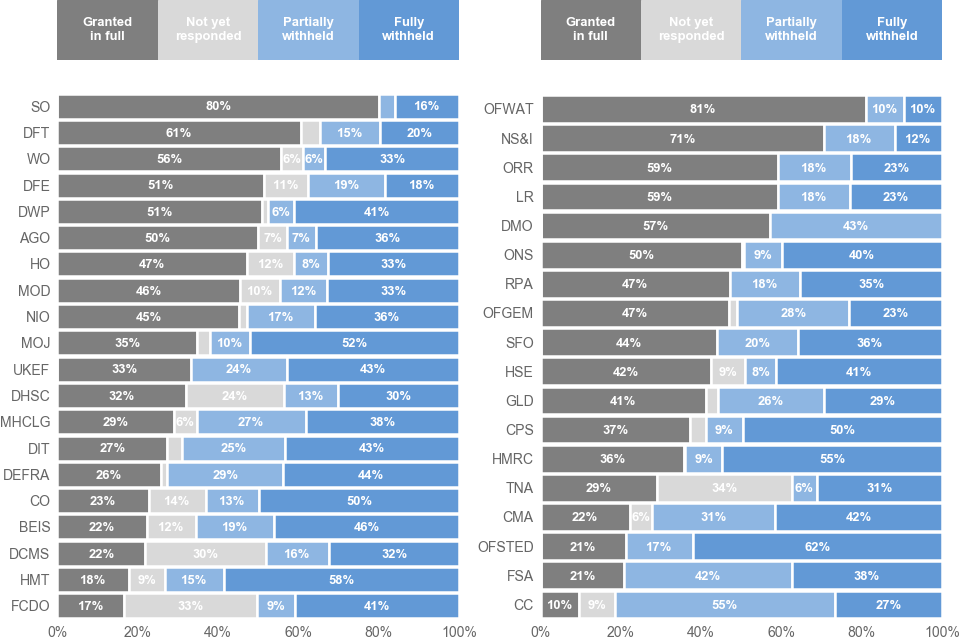
4.3 Outcomes excluding procedural refusals
12,983 “non-routine”* requests were received in April to June 2021. Of these, 7,935 (61%) were resolvable excluding procedural refusals. Of these:
- 3,654 were granted in full.
- 3,221 were withheld in full or in part, involving information subject to one of the exemptions and exceptions listed under Sections 22-44.
- 1,060 were not yet processed.
1,670 (13%) were procedural refusals. Of these:
- 163 were vexatious, as defined in Section 14 of the Act.
- 44 were repeated, as defined in Section 14 of the Act.
- 1,463 had a cost of response which exceeded the limit as defined in Section 12 of the Act.
3,373 (26%) requests were not resolvable. Of these:
- 734 requests required further clarification prior to responding, and monitored bodies provided “advice and assistance” on how to reformulate the request.
- 2,639 involved information not held by the responding body.
5 (0.0%) were on hold at the time of monitoring.
*For more detail and definition of ‘non-routine’ requests see Notes section.
Figure 4.2.1: Outcomes of FOI requests received in Q2 April to June 2021 (see Worksheet 6 of data tables and csv dataset)
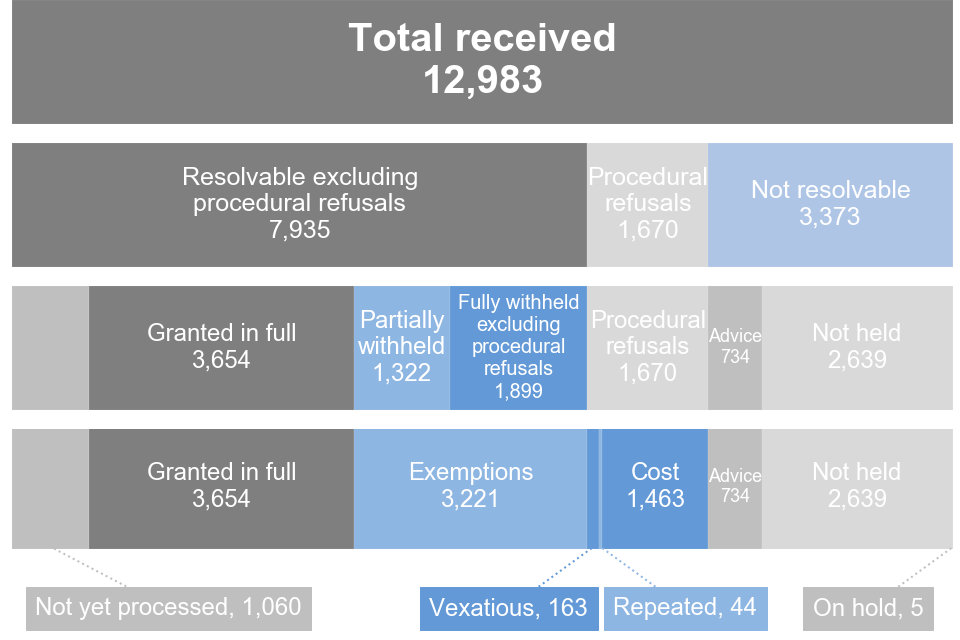
Figure 4.2.2: Departments of State and other monitored bodies: Outcomes of FOI requests as a percentage of resolvable requests excluding procedural refusals (see Worksheet 6 of data tables)
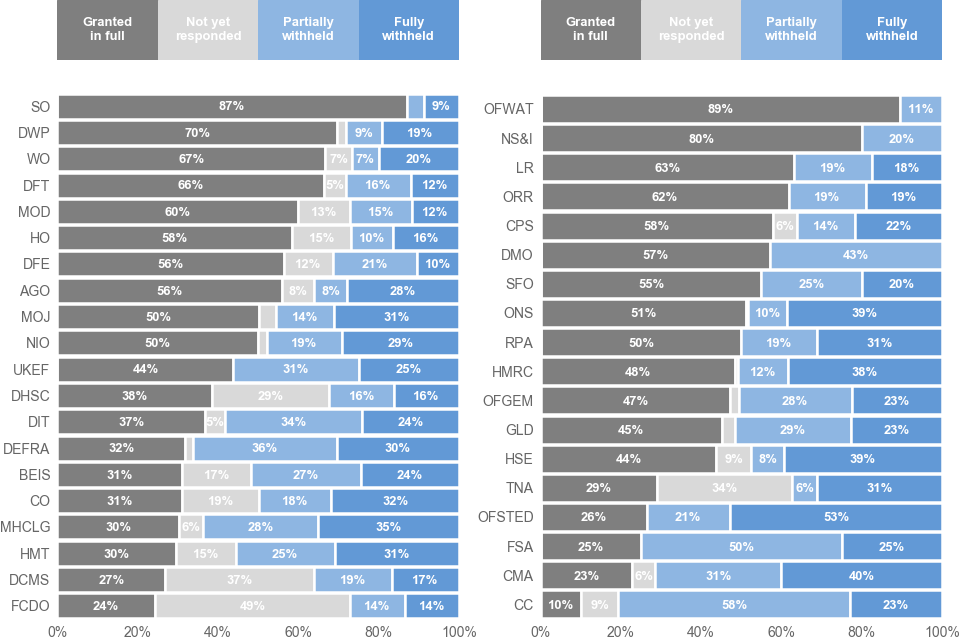
5. Exemptions
5.1 Exemptions
Under the FOI Act, public bodies can only refuse to provide requested information that they hold if the information falls under one of the specific exemptions within the Act.
Of the 4,891 requests withheld in full or in part, 30% were withheld due to the cost of response exceeding the statutory limit, 4% as vexatious or repeated, and the remaining 66% concerned exempt information. Of these, Section 40 (covering personal information) was by far the most commonly cited, as in previous quarters.
5.2 Section 21
A Section 21 exemption can be used under the FOI Act when information is reasonably available by other means. Requests where a Section 21 exemption was the sole exemption used are reported separately because the FOI Act is not meant to act as a means to access data in the public domain.
Across all monitored bodies 710 requests subject to a Section 21 exemption were reported.
Figure 5.1: Use of exemptions* in Q2 April to June 2021, as a percentage of all exempted requests (see csv dataset)
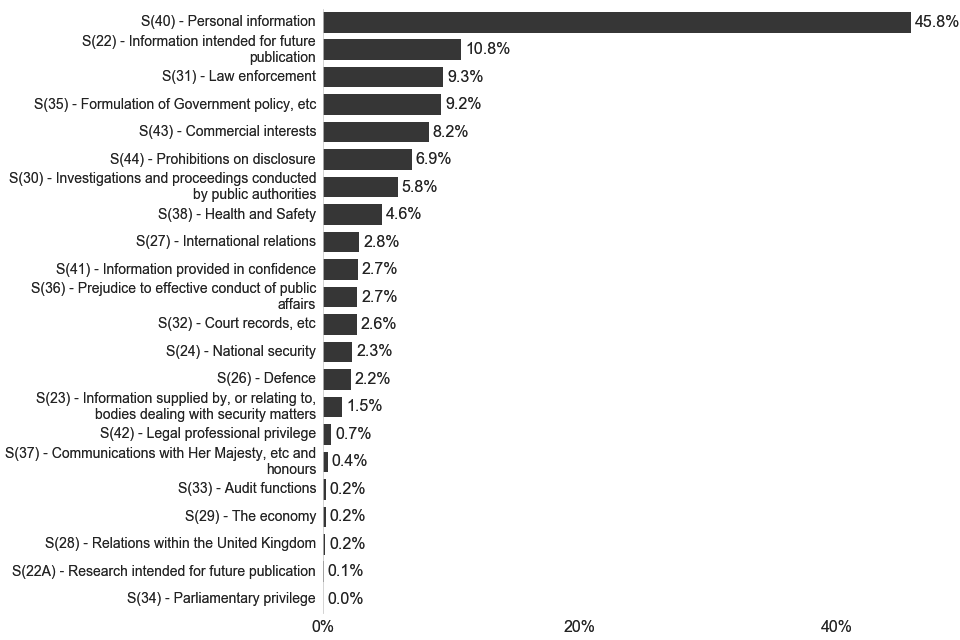
*Note that exceptions under EIRs are not included here
Figure 5.2: Departments of State and other monitored bodies: Volume of requests subject to a Section 21 exemption in Q2 April to June 2021 (see Worksheet 11 of data tables)

5.3 Statistical Notes
Percentages for exemptions may sum to more than 100 as each request may cite multiple exemptions. Requests exempted under Section 21 are not counted in any other figures.
6. Scope of monitoring
6.1 Bodies included in centrally monitored statistic
| Government body | Note |
|---|---|
| Attorney General’s Office (AGO) | Department of State |
| Crown Prosecution Service (CPS) | Body monitored separately from parent department |
| Serious Fraud Office (SFO) | Body monitored separately from parent department |
| Crown Prosecution Service Inspectorate | Unmonitored body |
| Business, Energy and Industrial Strategy (BEIS) | Department of State |
| Advisory Conciliation and Arbitration Service | Unmonitored body |
| Companies House | Unmonitored body |
| Insolvency Service | Unmonitored body |
| Met Office | Unmonitored body |
| UK Intellectual Property Office | Unmonitored body |
| UK Space Agency | Unmonitored body |
| Cabinet Office (CO) | Department of State |
| Crown Commercial Service | Body included in monitoring by parent department |
| Government Equalities Office | Body included in monitoring by parent department |
| Government Property Agency | Body included in monitoring by parent department |
| Ministry of Housing, Communities and Local Government (MHCLG) | Department of State |
| Planning Inspectorate | Unmonitored body |
| Queen Elizabeth II Conference Centre | Unmonitored body |
| Department for Digital, Culture, Media and Sport (DCMS) | Department of State |
| Department for Education (DFE) | Department of State |
| Education and Skills Funding Agency | Body included in monitoring by parent department |
| Standards and Testing Agency | Body included in monitoring by parent department |
| Teaching Regulation Agency | Body included in monitoring by parent department |
| Institute for Apprenticeships and Technical Education | Unmonitored body |
| Department for Environment Food and Rural Affairs (DEFRA) | Department of State |
| Rural Payments Agency (RPA) | Body monitored separately from parent department |
| Animal and Plant Health Agency | Unmonitored body |
| Centre for Environment, Fisheries and Rural Affairs | Unmonitored body |
| Veterinary Medicines Directorate | Unmonitored body |
| Department for International Trade (DIT) | Department of State |
| Department for Transport (DFT) | Department of State |
| Driver and Vehicle Licensing Agency | Body included in monitoring by parent department |
| Driver and Vehicle Standards Agency | Body included in monitoring by parent department |
| Maritime and Coastguard Agency | Body included in monitoring by parent department |
| Vehicle Certification Agency | Body included in monitoring by parent department |
| Department for Work and Pensions (DWP) | Department of State |
| Health and Safety Executive (HSE) | Body monitored separately from parent department |
| Department for Health and Social Care (DHSC) | Department of State |
| Medicines and Healthcare Products Regulatory Authority | Unmonitored body |
| UK Health Security Agency | Unmonitored body |
| Foreign, Commonwealth and Development Office (FCDO) | Department of State |
| FCDO Services | Body included in monitoring by parent department |
| Wilton Park Executive | Body included in monitoring by parent department |
| HM Treasury (HMT) | Department of State |
| Debt Management Office (DMO) | Body monitored separately from parent department |
| Office for Budget Responsibility | Body included in monitoring by parent department |
| Government Internal Audit Agency | Unmonitored body |
| National Infrastructure Commission | Unmonitored body |
| Ministry of Defence (MOD) | Department of State |
| Defence Electronics and Components Agency | Body included in monitoring by parent department |
| Defence Equipment and Support | Body included in monitoring by parent department |
| Defence Science and Technology Laboratory | Body included in monitoring by parent department |
| Submarine Delivery Agency | Body included in monitoring by parent department |
| UK Hydrographic Office | Body included in monitoring by parent department |
| Ministry of Justice (MOJ) | Department of State |
| HM Courts and Tribunals Service | Body included in monitoring by parent department |
| Legal Aid Agency | Body included in monitoring by parent department |
| HM Prison and Probation Service | Body included in monitoring by parent department |
| The Office of the Public Guardian | Body included in monitoring by parent department |
| Criminal Injuries Compensation Authority | Unmonitored body |
| Northern Ireland Office (NIO) | Department of State |
| UK Export Finance (UKEF) | Department of State |
| Scotland Office (SO) | Department of State |
| Wales Office (WO) | Department of State |
| HM Revenue and Customs (HMRC) | Other monitored body |
| Valuation Office | Body included in monitoring by parent department |
| Charity Commission (CC) | Other monitored body |
| Competitions and Marketing Authority (CMA) | Other monitored body |
| Food Standards Agency (FSA) | Other monitored body |
| Government Legal Department (GLD) | Other monitored body |
| The National Archives (TNA) | Other monitored body |
| Office for National Statistics (ONS) | Other monitored body |
| Office for Standards in Education, Children’s Service and Skills (OFSTED) | Other monitored body |
| Office of Gas and Electricity Markets (OFGEM) | Other monitored body |
| Office of Rail and Road (ORR) | Other monitored body |
| Land Registry (LR) | Other monitored body |
| Water Services Regulation Authority (OFWAT) | Other monitored body |
| National Savings and Investments (NS&I) | Other monitored body |
7. Notes
The FOI Act 2000[footnote 1] and the associated Environmental Information Regulations[footnote 2] 2004 allow individuals to request information from public bodies.
This bulletin presents FOI statistics for 38 central government bodies, including all major Departments of State, and a number of other bodies with significant regulatory, policy-making or information handling functions. The quarterly statistics report on:
- The initial handling of FOI requests
- The number received during the quarter
- The timeliness of issuing a substantive response
- The rates of disclosure of requested information
- The exemptions applied when withholding information
7.1 Corrections and Revisions
Monitored bodies review the figures provided in the quarterly monitoring, and may make internal revisions to the statistics after publication. The revised figures are then included in the annual end of year monitoring. As a result, the quarter to quarter statistics will not always sum to the annual figures. Where departments have made revisions to quarterly figures these will be noted in the statistical tables published in the annual report.
7.2 National Statistics
Freedom of Information statistics are designated National Statistics in accordance with the Statistics and Registration Service Act 2007. National Statistics status means that official statistics meet the highest standards of trustworthiness, quality, and public value. All official statistics should comply with the Code of Practice for Official Statistics[footnote 4]. They are awarded National Statistics status following an assessment by the UK Statistics Authority’s regulatory arm. The Authority considers whether the statistics meet the highest standards of Code compliance, including the value they add to public decisions and debate. FOI statistics were most recently assessed by the Authority during 2016, with continuing designation granted in June 2017.
7.3 Request for Feedback
We always welcome user feedback on our publications. We can be contacted at: foistatistics@cabinetoffice.gov.uk
7.4 Defining the scope of FOI monitoring
Section 1 of the Freedom of Information Act 2000[footnote 1] states that (subject to certain conditions):
‘Any person making a request for information to a public authority is entitled— (a) to be informed in writing by the public authority whether it holds information of the description specified in the request, and (b) if that is the case, to have that information communicated to him’
Regulation 5 of the Environmental Information Regulations 2004[footnote 2] states that (subject to certain conditions):
‘A public authority that holds environmental information shall make it available on request.’
Following their introduction on 1 April 2005, the above provisions apply to all relevant requests for information made to public authorities, no matter how routine and straightforward they may be.
Government departments supply large amounts of information, both on request and proactively, as an established and routine part of their business. This includes information released in the form of leaflets, correspondence exchanges, reports and other published material, and through websites and departmental FOI Publication Schemes. All information released on request is covered by the Freedom of Information Act, however it would be both uninformative and fundamentally unfeasible to count all such activity in departmental FOI monitoring returns.
The statistics in this bulletin therefore relate to all ‘non-routine’ information requests that government departments have received, and those routine information requests that are handled under Section 21. Essentially, this means that departments’ statistics should only count those requests where:
-
It was necessary to take a considered view on how to handle the request under the terms of the Freedom of Information Act, and
-
Departmental Freedom of Information officer(s) were informed of the request and logged it in their case management systems.
7.5 Defining a request
The full definition of an ‘information request’ for the purposes of inclusion in the Cabinet Office’s monitoring returns is shown below:
‘[An information request for monitoring purposes is one …]
-
Which meets the criteria in section 8 of the Freedom of Information Act and if the request falls under the Environmental Information Regulations it includes requests made in any form or context, including oral requests; and
-
Which is a request for information that is not already reasonably accessible to the applicant by other means; and
(i) Which results in the release of one or more documents (in any media) or inclusion of extracts of documents in the information released; or (ii) Results in information being withheld under an exemption or exception from the right of access (either the Freedom of Information Act or the Environmental Information Regulations); or (iii) The request is not processed because the department estimates the cost of complying would exceed the appropriate limit in accordance with section 12 of the Freedom of Information Act; or (iv)The request is not processed because the department is relying on the provisions of section 14 of the Freedom of Information Act; or (v) Where a search is made for information sought in the request and it is found that none is held.’
7.6 Consistency of the statistics
The definition shown above has been widely disseminated to FOI officers in government. It is necessary to apply a definition of this sort to set a clear boundary to the coverage of our monitoring, and thereby obtain meaningful information from the process.
However there is considerable variation in the way these bodies are structured and managed, and in the mechanisms that they have put in place to meet their obligations under the FOI Act. For example, some bodies operate a centralised Freedom of Information secretariat that co-ordinates responses to all information requests received. Others give a greater degree of autonomy to individual work areas in the handling of information requests.
Because of these differences, there could be a degree of inconsistency in the way in which bodies have interpreted and applied the definition of an ‘information request’ for monitoring purposes. However, the statistics effectively count those requests which have been dealt with by each monitored body formally under the FOI Act. As such, the statistics report on how many such requests for information each monitored body has received and how they have implemented the Act’s requirements in providing responses. Direct comparisons between the statistics for different monitored bodies can therefore be made on this basis.
In summary:
(i) These statistics cover both ‘non-routine’ information requests, and ‘routine’ information requests which are answered under a Section 21 exemption. This does not give a representative picture of all requests for information received in government.
(ii) There is likely to be a degree of inconsistency between monitored bodies’ interpretations of the definition of an ‘information request’ for monitoring purposes. This should be borne in mind when using these statistics.
7.7 Coverage
The statistics in this bulletin have been derived from monitoring returns completed by Freedom of Information officers in government departments during August 2021. The formal monitoring work covers a total of 38 central government bodies, including major Departments of State. The monitored bodies which are not Departments of State nonetheless have significant policy-making, regulatory or information-handling functions.
The Freedom of Information Act 2000 applies in England and Wales, Northern Ireland and Scotland (with exceptions, see below).
The Freedom of Information (Scotland) Act 2002 applies to public bodies over which the Scottish Parliament has devolved jurisdiction, and as such lies outside the scope of the monitoring work on which this bulletin is based. However, Scottish parts of UK-wide bodies which are ordinarily under the remit of the Scottish Parliament act (such as the Forestry Commission) are subject to the UKwide 2000 act rather than Scottish Government’s 2002 Act. A full list of the bodies covered by the monitoring statistics in 2019 can be found on page 8.
The Northern Ireland Office, Scotland Office and the Wales Office are included in these statistics as they fall under the jurisdiction of the UK-wide 2000 act. However, data is not collected from the Welsh Government or Northern Ireland Executive.
Statistics on FOI requests made to the Scottish Government can be found here: http://www.gov.scot/About/Information/FOI/Reporting. Note that there are several differences in the UK and Scottish FOI Acts which mean that the figures are not directly comparable.
7.8 Users and uses of the statistics
The main users of these statistics are departmental FOI teams responsible for coordinating responses and requests, Ministers and officials with responsibility for developing information access policy, and other non-governmental bodies and individuals with an interest in the accessibility of government information. The statistics are used to monitor the implementation of the FOI Act by central government, both as a whole and by each individual body included in the figures
7.9 Coronavirus (COVID-19)
The impact of the coronavirus (COVID-19) pandemic will have affected a number of the statistics presented for each quarter since Q1 2020 and in particular those on ‘Timeliness’ and ‘Volumes’. These impacts will vary by organisation and over time. Caution is advised when interpreting these statistics and in comparing them with pre-pandemic time periods.
7.10 Revisions
The underlying times series data for Figure 1.1 have been revised to correct for an error in the data for the period Q2 2018 to Q3 2020. This revision affects only Figure 1.1 and does not affect any other numbers or figures contained elsewhere in this bulletin or in any of the associated data tables.
See the quality and methodology information document[footnote 3] for further detail
